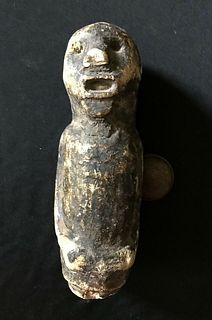Large / Portly Colima Dog Effigy Vessel
Lot 119
About Seller
Artemis Gallery
686 S Taylor Ave, Ste 106
Louisville, CO 80027
United States
Selling antiquities, ancient and ethnographic art online since 1993, Artemis Gallery specializes in Classical Antiquities (Egyptian, Greek, Roman, Near Eastern), Asian, Pre-Columbian, African / Tribal / Oceanographic art. Our extensive inventory includes pottery, stone, metal, wood, glass and textil...Read more
Estimate:
$5,000 - $6,500
Absentee vs Live bid
Two ways to bid:
- Leave a max absentee bid and the platform will bid on your behalf up to your maximum bid during the live auction.
- Bid live during the auction and your bids will be submitted real-time to the auctioneer.
Bid Increments
| Price | Bid Increment |
|---|---|
| $0 | $25 |
| $300 | $50 |
| $1,000 | $100 |
| $2,000 | $250 |
| $5,000 | $500 |
| $10,000 | $1,000 |
| $20,000 | $2,500 |
| $50,000 | $5,000 |
| $100,000 | $10,000 |
| $200,000 | $20,000 |
About Auction
By Artemis Gallery
Feb 11, 2021
Set Reminder
2021-02-11 12:00:00
2021-02-11 12:00:00
America/New_York
Bidsquare
Bidsquare : Animals in Art | Antiquity to Present Day
https://www.bidsquare.com/auctions/artemis-gallery/animals-in-art-antiquity-to-present-day-6391
From beloved pets to dedicated servants and vital livestock to symbolic imagery from many religions, animals frequently show up in the art of all cultures, ancient times to the present. Artemis Gallery info@artemisgallery.com
From beloved pets to dedicated servants and vital livestock to symbolic imagery from many religions, animals frequently show up in the art of all cultures, ancient times to the present. Artemis Gallery info@artemisgallery.com
- Lot Description
Pre-Columbian, West Mexico, Colima, Protoclassic Period, ca. 100 BCE to 250 CE. Likely the largest Colima dog vessel we have laid our eyes upon, this skillfully hand-built redware corpulent canine has a portly abdomen supported by four attenuated legs, with an upturned tail which doubles as the spout. His lively head boasts incised wide-opened ovoid eyes, an upturned snout with impressed nostrils, a smiling perhaps smirking mouth as if he is about to get into mischief, and a pair of perky ears that are pierced for decorating with ornaments. Highly-burnished and covered in red slip as well as fabulous root marks and manganese deposits, this is a wonderful example from ancient West Mexico! Size: 16.25" L x 9" W x 10.8" H (41.3 cm x 22.9 cm x 27.4 cm)
Scholars know of at least two types of Colima dogs, one to be fattened up and ritually sacrificed or eaten and one to serve as a watchdog and healer of the ill. This plump hairless canine known as a Chichi or Escuintla is thought to be related to the Chihuahua or Mexican Hairless also known as the Xoloitzcuintle. The Xolo dog was named for the deity Xolotl, the God of the Underworld, and believed to guide the deceased as they journeyed to the afterlife. Colima vessels such as this one were buried in shaft tombs to protect the deceased and provide sustenance for eternity.
See a similar example in the collection of the Brooklyn Museum (object number 37.390).
Provenance: ex-private Los Angeles, California, USA collection before 1980
All items legal to buy/sell under U.S. Statute covering cultural patrimony Code 2600, CHAPTER 14, and are guaranteed to be as described or your money back.
A Certificate of Authenticity will accompany all winning bids.
We ship worldwide and handle all shipping in-house for your convenience.
#150323Front right leg reattached. Tip of back left leg restored. Nicks to peripheries of ears, snout, and other high pointed areas. Covered with burnishing marks, manganese deposits, fly larvae markings, and root marks!Condition
- Shipping Info
-
All shipping is handled in-house for your convenience. Your invoice from Artemis Gallery will include shipping calculation instructions. If in doubt, please inquire BEFORE bidding for estimated shipping costs for individual items.
-
- Buyer's Premium



 EUR
EUR CAD
CAD AUD
AUD GBP
GBP MXN
MXN HKD
HKD CNY
CNY MYR
MYR SEK
SEK SGD
SGD CHF
CHF THB
THB
















